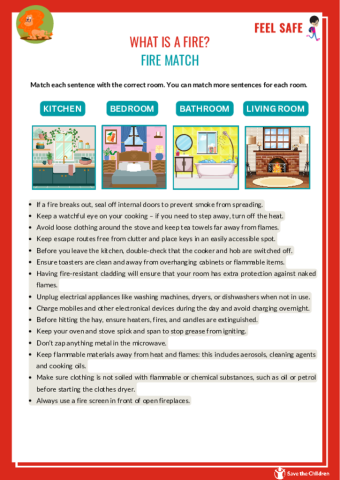What is a fire?
Objectives:
- Know the fire triangle
- Know the correct behaviors in case of a house fire
- To stimulate group work
STEP BY STEP
Before starting
The teacher introduces the topic by sharing the following trivia with the class and stimulating discussion. How many do students know?
- Scientists believe that humans began using fire to cook food in a controlled way about 1 million years ago.
- Flames are the part of fire that we can see and can be different colors, depending on the substance that is burning.
- A candle flame typically burns at about 1,000 degrees Celsius.
- Earth is the only known planet in our solar system where fire can burn. This is because no other planet in our solar system has the right combination of elements to support combustion.
What is a fire?
The teacher then proceeds to explain to the class what a fire is and how it originates, from a scientific point of view. The following definition can be used:
Fire is a chemical reaction that occurs when heat and a fuel source combine with oxygen in the air, creating flames and giving off light and smoke.
In order for a fire to occur, there are three elements that must be present at all times, which make up the so-called "fire triangle." The elements are:
- Oxygen: it is essential for combustion. It is present in the air we breathe and, when combined with fuel, helps to release energy in the form of heat and light).
- Heat source: it is the initial spark, flame or high temperature that starts the reaction between the fuel and oxygen. Once the fuel begins to burn, it generates more heat, sustaining the fire).
- Fuel: solid, liquid or gaseous. Different fuels can produce different types of flames and temperatures).
Warning. If one of the elements of the fire triangle is missing, the fire will not occur or will go out.
Fire can occur in nature in a combination of different colors, usually from yellow to orange or red. These colors depend on the temperature of the flames.
Fire management
Fire management is a key strategy to protect people and the environment. Fire management includes several stages:
- Prevention: The first step in fire management is to prevent fires themselves. This is probably the most important step! It involves educating people about fire safety and eliminating objects that could easily catch fire.
- Planning: Fire management is about having a well-thought-out strategy in the event of a fire. This includes evacuation plans, the creation of barriers such as firebreaks to stop the spread of fire, and the availability of equipment and trained personnel to deal effectively with fires.
- Suppression: When a fire occurs, we provide qualified experts who use tools such as fire hoses, fire trucks, and even helicopters to control and extinguish the flames.
- Monitoring: Even after the fire has been extinguished, it is necessary to continue monitoring the affected area. This way we ensure that there are no sparks or hidden embers that could reignite the fire, causing further damage.
- Restoration: After a fire is extinguished, the job is not finished. We assess the damage and then take steps to help the environment recover. This may involve replanting trees, restoring habitat for wildlife, and assisting communities in rebuilding what they have lost.
House fires
Now that the class is familiar with the basics of fire, the teacher divides the class into small groups and gives each of them the "Fire Match" fact sheet (see attached "What is a fire? - Fire Match" below). Each group should follow the instructions on the card and work together to test how much knowledge they have about fire safety at home.
At the end of the exercise, the teacher asks each group to share their answers and invites them to explain the rationale behind their association.
Concluding thoughts
The teacher makes children think about the importance of taking safety measures at all times when at home and the importance of sharing these measures with others to participate in the fire management process.
The topic can be further explored by consulting the document Home Fire Safety Guide (link).

Add new comment